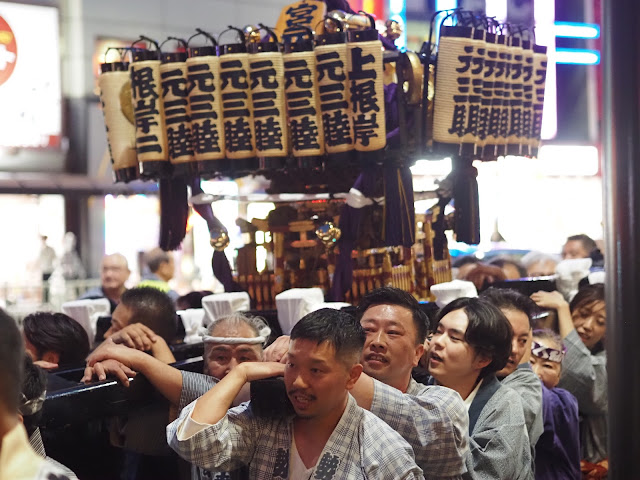Lunch with Hideki
I last visited Tokyo in 2014. Over the past 10 years, every time there was a big earthquake I'd inquire: "Did your apartment fall down?"
"Still standing. How are you?"
Back then it was a shared bench in Ueno park. Today, lunch.
He's now married with a 7-year-old son who is obsessed with Shogi, a kind of Japanese chess. His wife is a professional pianist, mostly for ballet performances.
"So ... small apartment, big piano?"
He laughs. "Yes, yes. You understand."
He took today off from work to hang out, so this is a big deal for both of us. Before lunch, he astounds me by leading me to a tea ceremony where a young woman named Atsuko, a fifth-generation tea master, shows us a number of 250-year-old bowls from which to drink our matcha.
Pick one, she says.
I shouldn't have been surprised by this turn of events. A few weeks ago I asked Hideki if he had had a chance to watch the new iteration of the TV miniseries "Shogun," and I sent him a link to this amazing scene where a samurai prepares tea for his wife as a prelude to what he hopes will be a joint suicide pact.
Not 10 minutes later, he responded.
"You're not going to believe this, but I have been studying the tea ceremony for the past 10 years."
There is a concept in Japan called "wabi-sabi," an aesthetic that finds beauty in imperfections. I choose a bowl that I find most imperfect. Atsuko compliments me on my discernment. Deflecting praise, as I was taught in my Pimsleur language lessons, I offer "Lucky guess." One of my better moments.
An intense curiosity overtakes me as she ladles the hot water and whisks the powder. The Japan-ness is strong.
Her work partner presents the bowl to me with a deep bow. I am expected to hold this museum piece from the time of the American Revolutionary War in the palm of my left hand while rotating it two or three times to the right so that my lips do not touch the handsomest part of the vessel. No pressure.
The ritual is designed to remove yourself from the bustle of the world, says Atsuko. The lily buds in a vase in the background, on the second day of May, symbolize at once potential and impermanence. Nothing lasts forever, but that's what gives everything beauty. Behind the vase is an image of a samurai (or some kind of god) fighting off evil spirits. If you visit her shop at another time of year, a different image will be there, a different unbloomed flower will be in the vase.
She asks me how I liked the tea.
Be restrained and thoughtful, says my inner voice. Foreign territory for this savage.
I clear my throat.
"Uh, very mild. And pleasing to the senses."
She seems delighted. But the Japanese are the world's best liars.
A box of miniature origami figures is presented. "Please choose one to remember us by."
"I'll take the elephant, so I never forget this day."
"What a glib asshole," I hear her thinking.
Dear reader, I am broken. My hostess is utterly sincere. The thing is, this country psyches me out.
Yuka-An is the name of this splendid oasis. Be assured, you sit in chairs and keep your shoes on. Definitely call ahead though.
Hey, there's Atsuko at the door!
Next, Hideki and I head to a little sushi spot he'd never been to before. On the TV, the Dodgers are boat-racing the Diamondbacks 8 to zip. Behind the counter, it's a one-man crew. We are the only customers. Seeing my camera, the chef asks Hideki that I not take photographs of anything beyond my plate, and my friend relays this to me in English. I totally respect this, but let me just say that the influencers have ruined everything.
Hideki and I order the same sets, 2800 yen (about $18 USD). It is a howling deal.
The chef is shaved bald and has one of those round white towel things on his head, kind of like a headband, but higher and tubular, held just by gravity and sweat. For several minutes he slaps fish fillets on top of hand-pressed rice cylinders, occasionally looking up to watch the baseball massacre.
The plates come. We are both in food heaven; I can't even remember what we talked about aside from Hideki explaining the Meiji Restoration of 1868 and how there are more Shinto shrines and Buddhist temples here than there are convenience stores.
There are tuna rolls, and tuna sushi, and toro, the prized fatty part of the tuna's belly (upper right). Squid, mackerel, shrimp. We both express perfunctory guilt about eating the overfished tuna.
The Japanese have three freaking alphabets, so I couldn't begin to tell you what the name of this restaurant is, but I pinned it.
The address is 2-chome-5 Nezu, Bunkyo City, Tokyo 113-0031. I would never have the guts to enter a place like this without a Japanese companion. But now that I know where it is and how it works, why not?
We walk back to Nippori Station and say our goodbyes. Hideki insists that I call him if there's any "emergency," which I take to mean if I'm arrested or need a doctor or something. He's a good dude and laughs at my jokes. We do the whole "See you in 10 years" thing and poof, I'm on my own again, but much more relaxed about inhabiting this odd place.







Comments
Post a Comment